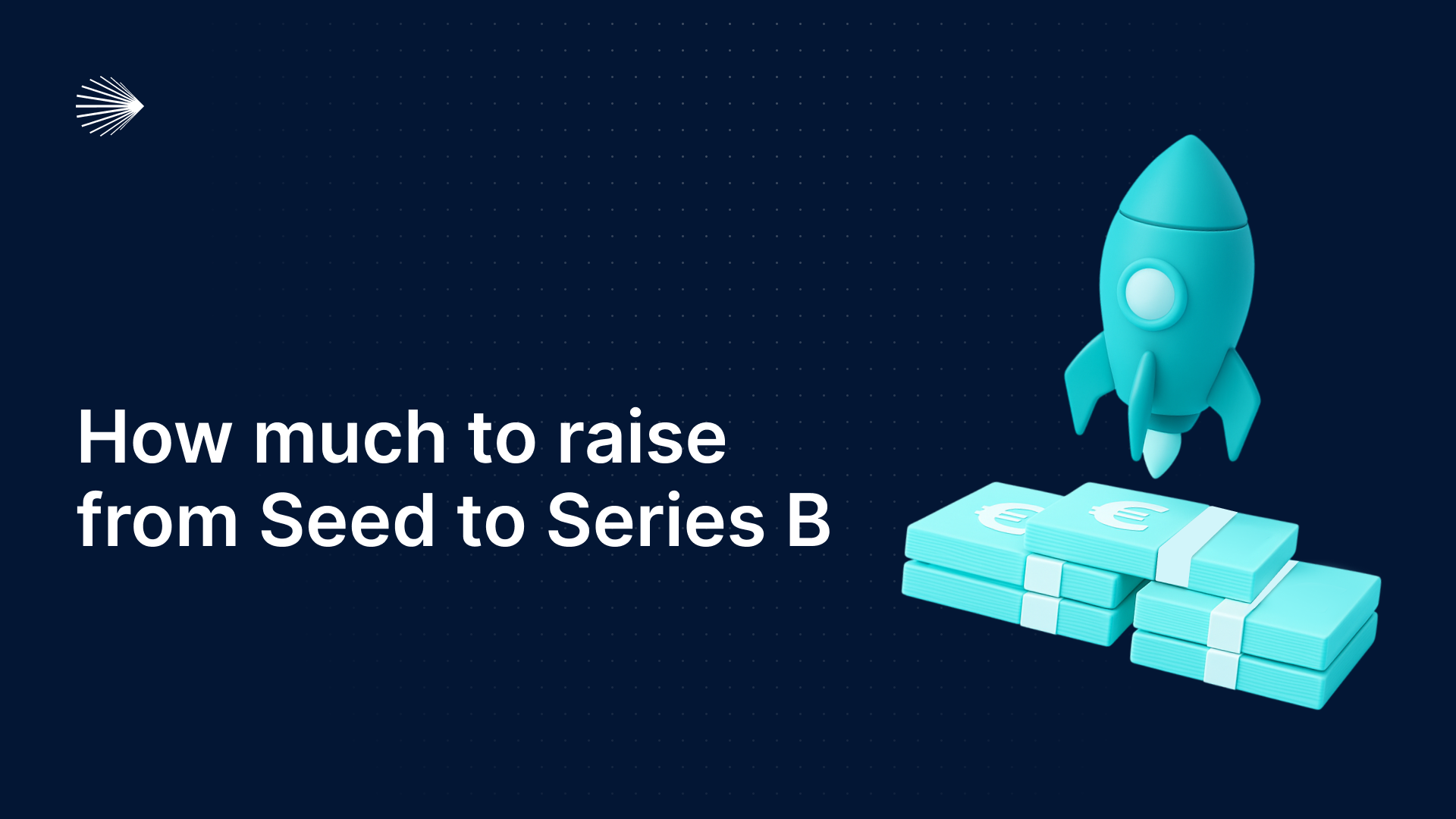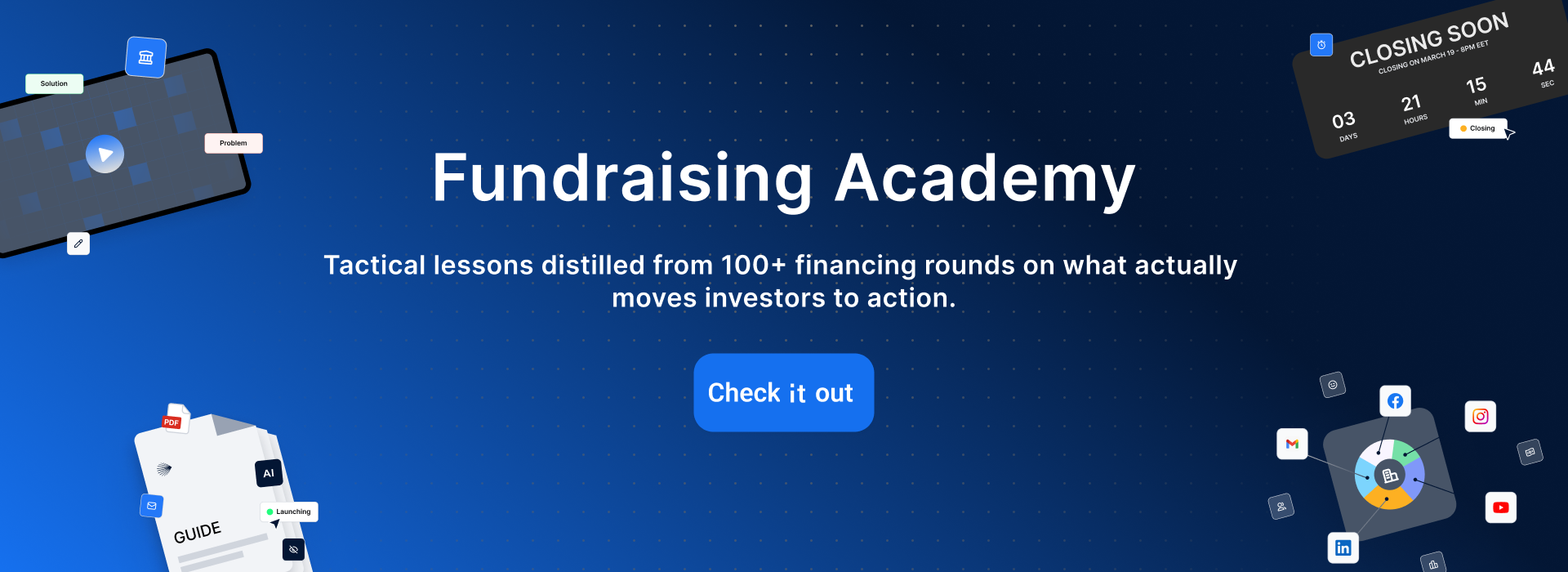Fundrasing
Learn how to estimate the right amount to raise at every stage and align your funding strategy with investor expectations.
August 28, 2025
·
8
min read

Founders often get so caught up in calculating runway and burn rate that they forget what truly moves investors: a clear, compelling vision backed by thoughtful planning. It’s not just, “We need €1M.” It’s, “We need €1M to build X, reach Y, and prove Z, and here’s how that unlocks real value.”
If you can tie your ask to specific milestones (not just survival), you're speaking the language investors understand. In this article, you’ll get a stage-by-stage breakdown of how much to raise, how to calculate it smartly, and what investors want to see. So, you can fundraise with purpose, not just pressure.
Raising money isn’t just about “how much runway do we need”, but also about buying time to prove something important at each stage of your company. The number changes depending on where your company is in its journey. Investors don’t just want to hear how much you need. They want to know why, what it’ll get you, and how it sets you up for the next stage.
The key is to raise just enough to get you to the next inflection point, the one that makes you a no-brainer for the next round of funding. Here’s how to figure out what that looks like based on where you are right now.
You’ve got the idea. Maybe a prototype or a few people saying, “I’d totally use this.” But you’re still in the earliest chapter, proving the concept, getting something real into the world, and trying not to burn out in the process.
Most founders at this stage are working nights, bootstrapping, or juggling side gigs. Pre-seed is all about building the foundations, your MVP, your first users, and maybe your co-founder or first hire. The goal isn’t to perfect everything; it’s to validate enough of your idea to show that it’s worth pursuing further.
This is typically when startups begin hiring beyond the founding team, investing in go-to-market strategies, and establishing measurable goals. You’re still in the discovery phase, but now it’s more about repeatable traction than pure exploration.
You’ve got momentum. People are using (and ideally paying for) your product. You’ve found some channels that work, and now the question is: Can this scale?
Series A is where things get serious. Investors want to see efficiency, not just that you can grow, but that you know how to grow in a smart, sustainable way. This is where you start thinking about org structure, revenue targets, and long-term scalability.
Investors need to understand how their capital will be utilized, what it will enable the company to achieve, and how it will enhance the company’s value before the next round.
To evaluate that, investors look for specific indicators of planning, focus, and financial responsibility. They want to see that you're not just solving a meaningful problem, but that you're making smart, strategic decisions about how to grow. Below are five key things they expect from founders in any fundraising conversation.
Investors expect your fundraising ask to be tied to tangible, time-bound milestones — not just general goals like “growth” or “scale.” These milestones should be specific, measurable, and aligned with your stage of development.
For example, this might include completing product development, reaching €100,000 in monthly recurring revenue, onboarding 10 enterprise customers, or expanding into a new market. They show that you understand what needs to happen before your company becomes significantly more valuable.
When you can map out how this round of funding gets you from one phase to the next, and why that next phase justifies a higher valuation, it gives investors a much stronger reason to commit.
Need help aligning your fundraising with concrete milestones? Explore SeedBlink’s Fundraising Academy to learn how to define clear, measurable goals that support your funding ask.

One of the most common red flags for investors is when a founder sets a funding target without providing a clear explanation of where the number originates. Simply saying, “We’re raising €1M” isn’t enough.
Investors expect a data-backed rationale that explains how you arrived at that number based on operating costs, hiring needs, marketing plans, and product development timelines. Providing a rough financial model, even a simple one, builds credibility. It demonstrates that you’ve forecasted what your business needs over the next 12–24 months, and that you understand how to manage cash and allocate resources.
The exact projections may change over time, but demonstrating a thoughtful approach to financial planning gives investors more confidence in your leadership.
Along with the “how much,” investors want to know the “how it’s used.” A strong use-of-funds breakdown includes key categories such as team growth, product development, marketing and customer acquisition, operating costs, and a reserve for unexpected expenses. Each category should reflect your strategic priorities for the next 12–24 months.
It’s important to be realistic. If you're hiring, be clear on which roles and what they’ll contribute. If you're spending on marketing, specify the channels and the type of returns you expect. Having a clear capital allocation plan shows investors that you’ve thought through your next phase of execution, not just your product vision. It also helps them evaluate whether the raise amount matches the plan.
Investors want to know that the capital they invest now will help your company reach a stage where its valuation increases significantly.
To do this, founders should be able to articulate how their planned progress translates into valuation growth. For example, a startup going from pre-revenue to €1M ARR, or proving scalable customer acquisition, is in a much stronger position to raise at a higher valuation in the next round.
Being clear about this pathway helps investors see the long-term upside of getting in now.
Timing matters just as much as the amount you raise. Ideally, you want to start fundraising when you still have at least 6 months of runway. This gives you breathing room to run a proper process, talk to multiple investors, and avoid accepting unfavorable terms out of urgency. Starting too late puts you at a disadvantage and can disrupt your operations.
A typical fundraising process can take 3–6 months, from preparation to receiving the cash in the bank. This includes refining your pitch, creating materials, scheduling meetings, conducting due diligence, and negotiating terms. Build this into your calendar, and always be working toward clear progress that makes your startup more fundable by the time you start your next raise.
To make the process easier for you, we’ve prepared a complete roadmap for when and how to raise. You can find it on SeedBlink’s Fundraising 101 guide that breaks down the entire fundraising process, from preparation to closing, so that you can plan everything.
When you under-raise, you may find yourself running out of cash before hitting the milestones that make your next round possible. That puts you in a weak negotiating position, forces rushed decisions, and often leads to bridge rounds or down rounds that dilute you more than necessary.
Under-raising can also create unnecessary pressure. Instead of focusing on building and testing, you’re stuck constantly watching the runway. It’s better to raise enough to comfortably reach a clear inflection point in your business than to aim low and struggle to keep up.
Large rounds often come with larger expectations, faster burn rates, and a false sense of security. If your business doesn’t progress at the pace the funding implies, future investors may hesitate to fund you again, or push for performance you’re not ready for. Additionally, the more you raise early, the more equity you give up, often at a lower valuation than you could command later. Founders sometimes assume that more capital equals less risk, but in reality, it can lead to excessive spending on unnecessary items and the waste of part of the capital.
Whether you're just starting out or preparing to scale, the key is to raise with intention. At SeedBlink, we help early-stage and growth-stage startups raise smarter. From structuring your round to showcasing your story, we’re here to help you raise capital with clarity, confidence, and credibility.
Our strting plan is built for founders who need to move fast and smart: The platform helps you prepare, pitch to investors, and raise capital without breaking the bank.